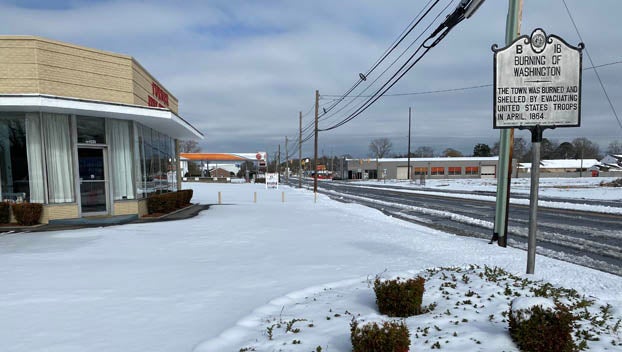Florence makes fourth year in five of losses for farmers
Published 7:49 pm Thursday, September 20, 2018

- PROBLEMS ABOUND: According Rod Gurganus, with the Beaufort County Cooperative Extension Service, a variety of problems can affect crops in the wake of a hurricane due to factors ranging from flooding and salt spray to winds and too much rain. (Daily News)
BEAUFORT COUNTY — In the wake of Hurricane Florence, farmers throughout Beaufort County are assessing damage to their crops this week. While some areas fared better than others, with damage more pronounced the farther south one travels, according to Beaufort County Cooperative Extension Service Director Rod Gurganus, the net result for Beaufort County farmers is economic hardship.
“The bottom line is this is another year where we are going to see reduced yields and reduced qualities on crops,” Gurganus said. “We’ve had that now for four of the last five years, on soy beans and cotton especially… there’s a cumulative effect there for us in terms of what the farmers are seeing economically.”
As one of Beaufort County’s top industries, Gurganus says that agricultural production equates to approximately $120 million in economic impact each year, dollars that in turn are spent in the local economy.
Of Beaufort County’s four main commercial crops — soy beans, cotton, corn and tobacco — each suffered losses, with some taking more severe hits than others.
SOY BEANS
From heavy inundation to burning from salt spray and leaves knocked off plants by winds, losses to soy bean crops are likely to be a mixed bag, due to varying stages of maturity at the time of the storm.
“We’ve got soy beans that have already been picked and some that will be picked in late October,” Gurganus said. “The beans that were ready to pick now, some of the guys were able to get them out. If they couldn’t get them out and they’re ready to pick, those are very vulnerable.”
Gurganus said that many of the younger plants may be resilient enough to make a decent harvest in October, assuming they haven’t lost too many leaves or been burned by salt spray.
COTTON
With cotton, there are a wide variety of issues that can occur. Stress applied at the right stage can cause bolls not to open at all, a condition called hard lock. On those that were already open, wind blew a considerable amount onto the ground. Other issues can include seed germination in the boll, which can decrease the quality.
“Cotton just has a lot of ways that it can be impacted by something like this,” Gurganus said.
TOBACCO
With a late start to the season, Gurganus says there was still a lot of tobacco in the fields, and hard winds from Florence caused a lot of stress, in turn opening the door for diseases, hard curing and plant death in general.
“What I’m hearing, for the most part what’s left in the field is ruined,” Gurganus said. “The problem is that the upper stalk tobacco, which is what is left in the field now, is the best quality leaf. It’s also their profit. They’re basically going to lose all their profit this year because they weren’t able to get that tobacco in.”
CORN
According to Gurganus, many farmers throughout the county had already harvested corn crops before the storm hit, minimizing losses. For those who had yet to harvest, conditions vary from unaffected to having entire fields laid over on the ground.
“There’s varying degrees of damage there,” Gurganus said. “It really kind of depends on where it was at and if there was some wood line nearby to protect it, that helped.”
Gurganus said that he has generally seen more corn knocked down on the south side of the river than the north side.
LIVESTOCK
While Beaufort County is home to a few hundred heads of cattle, there are practically no large poultry operations like those in the Neuse and Cape Fear river basins. According to Gurganus, hog producers in the county remained largely unaffected.
“We were far enough north that any impact we’ve seen on the livestock guys down south, we’re not seeing here,” Gurganus said. “None of them are in areas that would have flooded.”
RECOMMENDATIONS
While certain financial aid may become available as assessments become more complete, Gurganus says that the best thing farmers can do right now is contact the Beaufort County Farm Service Agency and discuss their situation.





